📑How to Write a Comprehensive Book Summary

I read 61 books in 2021.
I skipped from book to book, barely stopping to breathe between each one. At the end of the year, I looked back on all I had read and realized: I barely remembered a single idea.
This experience taught me a lesson: reading isn’t a race. It’s a marathon.
Setting a goal to read 100 books a year is practically cheating. The last year taught me I needed to slow down. So I started taking notes. But these notes simply collected dust; nothing was making me go back and read them.
Therefore I decided to create book summaries. I started taking my book notes and collecting them inside my second brain.
The app I used to do this was Roam Research, a revolutionary digital notetaking app that allows you to build your own Wikipedia of knowledge. Using Roam I began to write comprehensive book summaries. At first, it was clunky and hard. I didn’t know what I was doing. But as time went on, my book summarization skills got better.
After a couple of weeks, I noticed changes. My initial problem started to go away as I retained more from what I was reading.
But this was just the tip of the peanut butter. Soon, many other benefits I never expected started to show.
Let’s go over the major ones here:
- Absorb many more insights and lessons
- Create intellectual building blocks and your own personal Wikipedia
- Build a serendipity vehicle
Firstly, summarizing books makes you absorb many more lessons. Finding and connecting the major arguments of the author fosters understanding.
Many people falsely believe reading itself creates understanding. Only when you synthesize can you truly understand and writing is the ultimate act of synthesis.
Memory is undervalued today because of Google. But there’s magic to having deep conversations on the spot without a book in front of you.
Who else can say Teddy peanut butter was founded in 1925 by Michael Hintlian? Just me. Ok.
If done right, book summarization provides unique insights as your book summary will differ from the book; Your unique experiences, education, place of residence, relationships, and genetics, will cause your book summary to go through an intellectual phase transition.
Secondly, summarizing books creates intellectual building blocks and your own personal Wikipedia.
Intellectual building blocks are past works ready to create new things. Book summaries are my most valuable intellectual building blocks.
I often repurpose book summaries into YouTube scripts, blog posts, and email newsletters. Many of my book summaries made their way into the curriculum of my course, Building a Reading Habit.
This creates a beautiful compounding effect.
My past projects make future projects easier in turn creating more intellectual building blocks. I start some projects at 80% completion without even realizing it.
Over time, I grow my personal monopoly; a unique niche on the internet validated through shown work. My posts create an interconnected web of thinking others can follow in any order.
These articles are written by me, in my own language, with my own framing. I don’t have to leave readers behind by explaining backstory. It’s all there.
Third, summarizing books builds a serendipity vehicle.
A serendipity vehicle is crafted luck which comes through exposing your ideas to the internets magic. If you learn to write and promote, your posted book summaries become a magnet of people, opportunities, and ideas you didn't even know existed.
Let’s go over how book summarization does each.
Most books build their arguments slowly but in a book summary, you can lead with the gold first. You can be far more discerning and opinionated because you don’t have a publisher down your throat.
This combination fosters community by attracting people coming for your book summary but staying for your personality and story.
This in turn creates opportunities. Your book summary might give you access to an author for instance. How do you think authors choose who to meet?
Put yourself in their shoes. You have published a great book. Everyone has heard of you. Everyone wants to talk to you.
You will obviously prioritize those who have made your work more accessible through creating a book summary.
I met Matthew Dicks, the author of Storyworthy after reading his book and contacting him to come to TEDxCornells speaking event. I believe one of the reasons he said yes is I summarized his book.
The community and opportunities you create in turn make a magnet for ideas you didn’t know existed. You get exposed to other people's Infinite Library in turn giving you more ideas to write about in your book summaries.
Since I started back in June of 2021 I have written 10 long-form book summaries many of which are on my YouTube Book Squad playlist and a few on my website.
Many of my book summaries get repurposed into articles on my website.
Over this period, I have narrowed down a process for creating comprehensive book summaries.
There are many different levels of creating book summaries all of which I talk about in my video on the secret levels of creating book summaries.
In this blog, however, I will specifically talk about how to write comprehensive long-form book summaries which I reserve only for the best books I read. It’s where the three benefits we discussed earlier come into full effect. But it does take a long time. A REALLY long time.
For the average 300-page book, this process takes me around twenty to twenty-five hours.
Like with many of the most important things in life it’s easy to learn and difficult to master. Luckily, this summarization process doesn’t work only for books. You can use its principles to summarize emails, courses, articles, podcasts, anything.
Looking back on my life, one of my greatest regrets in life is I didn't start using this process sooner. Luckily, you won’t make the same mistakes I did because you’re here right now.
These are the rough steps of the process:
- Read to highlight/annotate.
- Progressively summarize book notes in a notetaking app.
- Outline and write the book summary using the ten-step writing framework.
- Edit, rewrite, and proofread as many times as it takes.
- Repeat.
How to use this article:
This next section functions as a step-by-step how-to guide for the process of comprehensive book summarization. I recommend you read it through once completely and then go back to each step when it becomes relevant with a book of your choice. You won’t learn book summarization through book learning. You have to go through the process yourself.
📝Highlighting/Annotating
🟨Highlighting
If you prefer this section in video format, check it out below.
Highlighting is like gold mining.
Books are long. Many authors embellish books by packing a whole lot of anecdotes or supporting evidence for each of their points. Like a gold miner, it’s our job to sift through the extra rock and find the golden nuggets of insight by highlighting.
This could be through an e-reader, audible, or physical book form. Every reading medium can work.
Physical highlighting simply requires a set of physical highlighters. Audible highlighting is a bit trickier. To be honest, I don’t highlight audible books much. I use audible books more for fiction and as testing grounds for books I might read physically or with an e-reader.
My favorite reading medium is an e-reader because creating highlights and annotations is seamless. But the main reason I love e-readers is they can connect with an app called Readwise. This book summarization process doesn’t require you to use Readwise but it makes it 10000% easier.
Readwise collects the highlights and attached annotations from books I read and syncs them up with Roam Research. Using some clever code, every book note comes with the author's name, the title of the book, and who recommended it to me along with the highlights and attached annotations below.

This is one example from a book I read recently called How to Read Like a Professor.
Readwise also lets you capture your highlights under the book's parts, chapters, and headings.

This is invaluable while writing your book summary as you are reminded of the context your highlight was taken under. And for any physical book lovers, Readwise lets you take a photo of a page and upload the highlight into your notetaking app!
Get 2 months of Readwise free using my affiliate link (Double the normal trial length).
To learn more about how to start using Readwise, check out the Readwise blog.
How to Actually Use What You Read With Readwise Part 1
➿My Highlighting Flow
While highlighting I use colors to help differentiate between highlights. I use yellow for interesting ideas, pink for studies, and blue for anecdotes.
And orange I use fo-
Oh. Orange isn’t used for anything. Orange is lonely.
This begs the question: how do you know what to highlight?
The Golden rule is to only highlight what resonates with you.
Before highlighting, make sure it passes two of three questions:
- Does it interest and captivate your attention?
- Does it have something unique and original to say?
- Does it help address the problems you face?
How do you know if information resonates? You pay attention to your body. Does your heart beat faster? Do your eyes dilate? Do you get a tingly feeling in your head?
This is a learned skill. You will get more and more attuned to your body's signaling mechanisms the more you highlight and annotate.
But this process only works if you consume quality information. Information is like food. If you highlight garbage, the other three pillars of your reading habit won’t have the foundation they need to succeed and your book summary will be trash.
Resonance reading, as I call it, is a perfectly good way of summarizing books. But to take your book summarization to the next step you should add the SQ3R framework into your reading toolkit.
Think of it as the difference between peanut butter and every other nut butter. Resonance reading is like peanut butter. It’s good. Really good.
But once you find out how many other nut butters are out there, you’ll wonder how you survived without them. Similarly, The SQ3R framework opens you up to highlights and annotations you never knew existed.
SQ3R operates on a series of five steps:
SURVEY: Glance over the headings in the chapter to see the few big points that will be developed. If the book has one, read the final summary.
QUESTION: Turn the first heading into a question. Your purpose while reading the chapter is to answer that question.
READ: Read to answer that question. This is not a passive plodding but an active search for the answer.
RECITE: Having read a section, look away from the book and try to recite the answer to the question in your own words. If you can't do this, glance over the section again. Repeat these four steps for each section.
REVIEW: When the entire lesson is read, look over it to get a birds' eye view of the lesson as a whole. Under each heading, try and recite the major subpoints.
By posing a question before reading a text, you give your reading session a purpose. Apart from simply finding ideas that resonate, you highlight to answer your questions as well.
But highlighting alone isn’t enough of a foundation for an effective book summary. Like gold requires refining to be used for currency, jewelry, and Minecraft swords which break in two seconds, highlighting needs annotation to rise to its full potential.
🗒️The Ultimate Guide to Annotation
"We have to choose between feeling smarter or becoming smarter. And while writing down an idea feels like a detour, extra time spent, not writing it down is the real waste of time, as it renders most of what we read as ineffectual." - Sohnke Ahren's How to Take Smart Notes
An annotation is a note or explanation added to a text. And there's something I realized soon after starting to create them.
Annotating is hard.
This was my first major roadblock on my book summarization journey. Highlighting was easy for me. But annotation took effort. Putting the book down and writing my own thoughts felt like a detour from reading.
It was only when I saw annotation as an integral part of the reading process that I started to ingrain it into my reading habit. Soon after, I realized its power. Without my own thoughts and context, my highlights felt dead. They were simply copied thoughts of the author with none of my own insight.
In addition, my annotations save me work when I write my book summaries. This is because they often remind me to include things in the book summary. In this way your annotations let your past self work for you.
Let’s go over some of the best principles I have found for annotating texts as I have gotten better.
My best tip is to keep one essential question in mind while you read: why are you reading?
Do you intend to create a book summary? Do you want to understand how the human body works? Are you fascinated by behavioral psychology and how it affects our decision-making? Are you infatuated by the history of peanut butter production? That last one might just be me.
One of the best things you can do to help with this is to create a list of your twelve favorite questions. These are the twelve questions you frame your entire life and information diet around answering. But these twelve questions can also serve as a guide to what you highlight and annotate.
Here are my twelve questions for inspiration when writing yours. Don't feel bad if you take a few of mine. I did the same with Tiago Forte when he showed me this process.
- How can I instill the most effective and sustainable reading habit into my and others' lives?
- How can I find and foster long-term relationships in my life?
- What does the Theory of Constraints have to teach us about our information diets, especially towards reading?
- How can I improve the skill of Happiness?
- How can I make my personal projects fun, helpful, and profitable at the same time?
- How can I build a second brain that works for me instead of against me?
- How do I create long-term intellectual property that is insightful and valuable years in the future?
- How do I balance short-term fun and long-term pain?
- How can I design the perfect lifestyle for me?
- How can I convey ideas in the most concise, useful, and interesting way possible?
- What can we do to make the internet work for us instead of against us?
- How can I balance time management with living in the present?
Alongside your twelve favorite questions here are a few ideas for ways you can annotate while reading.
Summarize large sections
Countless times I have read something and think, "wow, they could have said this way more concisely." Then, I highlight the series of paragraphs and summarize them in my own words. Your future self will thank you when they don’t have to read the entire section over again to get the main idea.
Recontextualize the information
When highlights pop up in your notetaking app through Readwise, they won’t have any context come in alongside them. It's your reading self's job to add the necessary background information in your annotation so your future self will understand it.
Connect to relevant information
One of the principal ways our brains store information in long-term memory is through elaboration. Elaboration is the art of connecting past knowledge with things you are learning right now. You could explain how a highlight relates to relevant information in your annotation.
Connect to a personal anecdote
Write down a personal story reflecting the highlighted passage. Humans have an ear for stories. For most of history, oral storytelling was the way we communicated.
Connect to an analogy
Humans remember images better than numbers. And it’s easier to understand new concepts if they connect to something we already understand. In this blog post alone, I have compared highlighting/annotating to gold mining and refining and related the SQ3R framework to nut butter. These analogies make it easier to visualize the parts of the book summarization process.
Make your future self laugh
Maybe the passage reminded you of something stupid you did as a kid. Some of my greatest laughs have been from my past self interacting with my future.
And that’s it. Highlighting and annotating are integral parts of the reading flow.
The next step of the book summarization process comes when you have read a book all the way through.
🐌sProgressive Summarization
Humans are incredibly sensitive to the way information is presented. Our eyes naturally gravitate toward anything which sticks out.
Progressive summarization is the art of bolding, highlighting, and summarizing information for our future selves. Think of progressive summarization as time travel. No, not the Dr. Who blue box time travel; I’m talking the real stuff.
While progressively summarizing we have to time travel our minds to the future and imagine what it would be like to see a note weeks, months, or even years down the line. Why is all this work necessary?
Your future self is lazy.
If a note isn’t easily actionable, they will likely let it sit in the dust. Your book notes need to be summarized well or your future self won’t bother writing a book summary.
Progressive summarization works in five steps:

For simplicity, I’ll progressively summarize an article called Supersizing the Mind: The Science of Cognitive Extension instead of a book so you don’t have to scroll through endless pages of highlights.
Layer 0: Layer 0 is the original text before going through the highlighting and annotating stages.

Layer 1: Layer 1 is the highlights and annotations Readwise brings over to your digital notetaking app of choice (for me Roam Research). This first layering took me around 10 minutes.
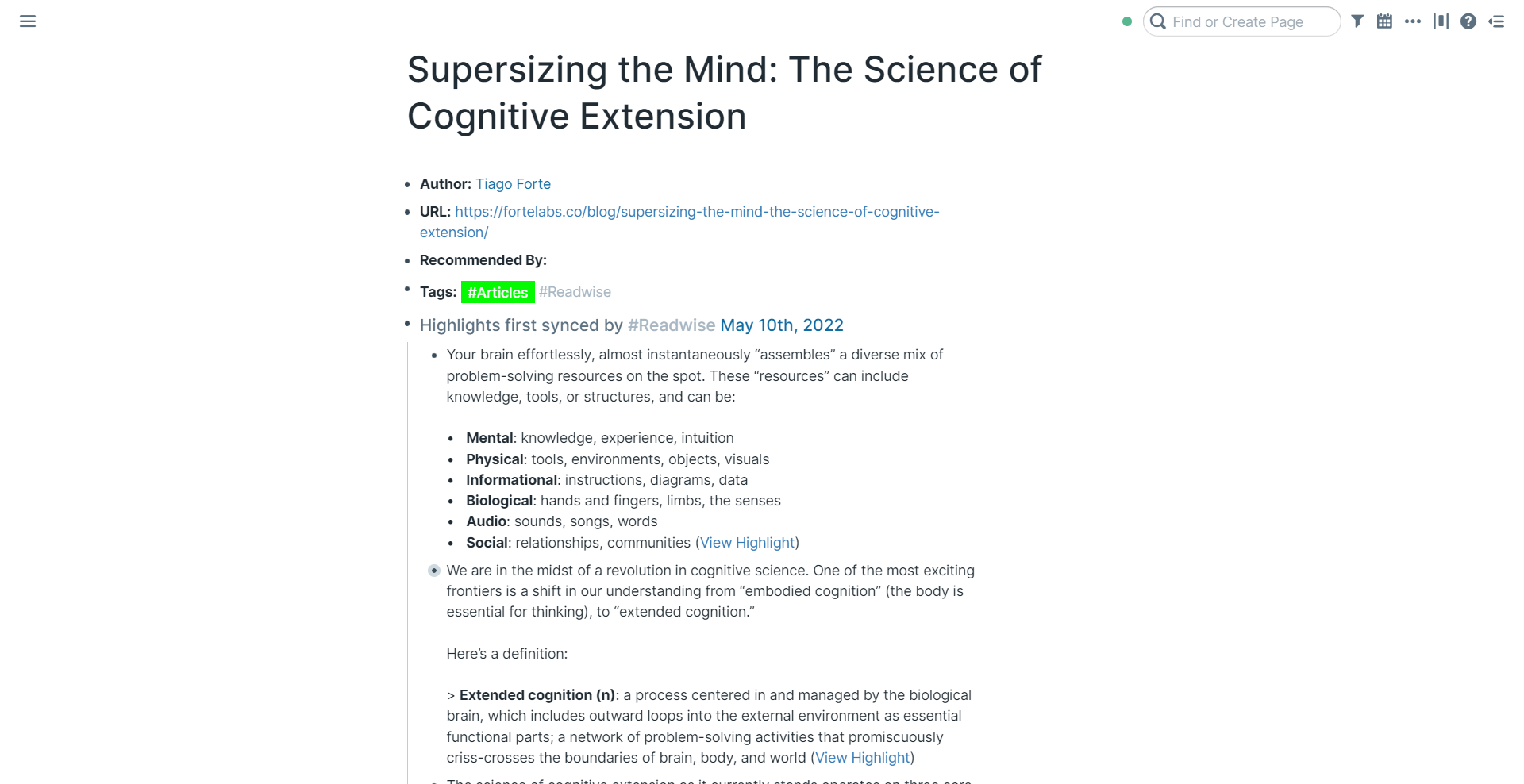
Layer 2: I formed layer 2 by going through and bolding the parts of the highlights which resonated with me most. I highlight it first because Roam Researches code is unique to other apps but you will probably bold. I used the same highlighting flow discussed before to form layer 2.
When you do this yourself make sure not to get stuck on a passage while moving through. Our analytical mind will only slow us down. Take some wisdom from Nemo and “just keep swimming” or moving to the next highlight in your case.
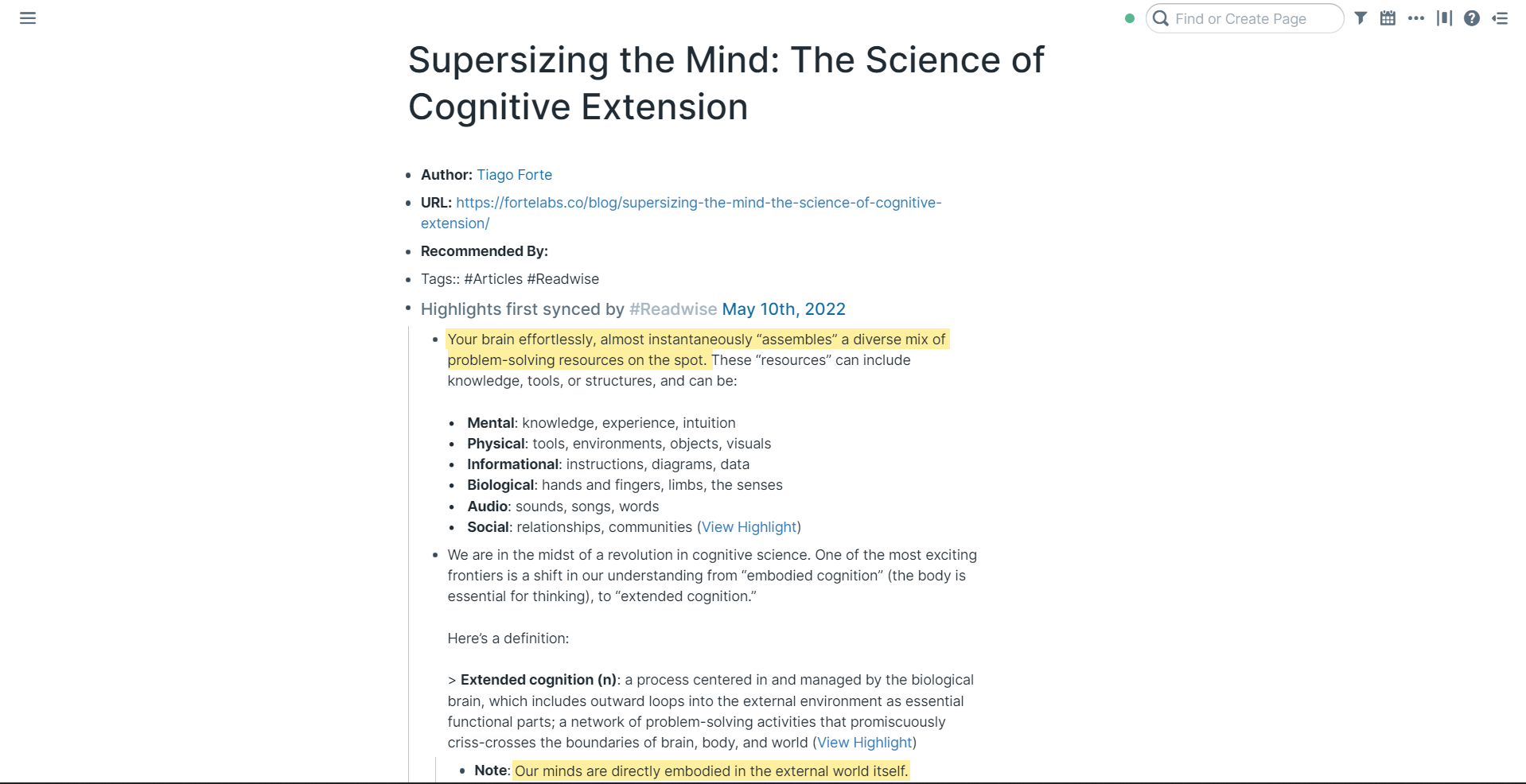

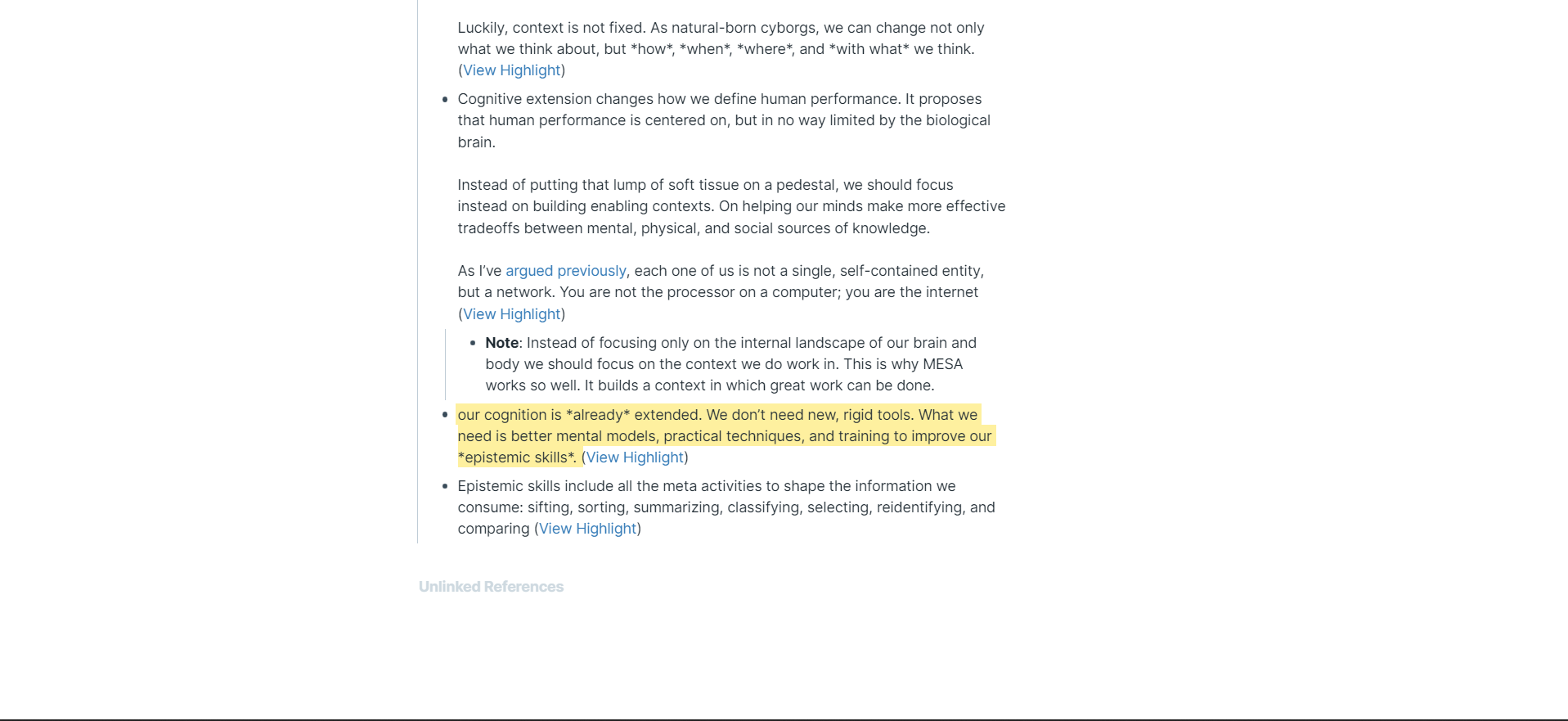
This took me around 1 minute. Let that sink in. In the future, I can get the gist of the article by glancing over the highlights rather than reading for five minutes.
The next part is essential. Let the note sit. We want to let the ideas have time to foster and grow in our minds.
When do you move to the next step? Follow the touch rule: touch a note for any reason and you have to summarize it in some way. This could be moving to the next layer of progressive summarization or making one small edit. Usually, this takes around a week to two months.
But you might never move to the next step; this is okay. Not all books should be summarized. I only go through this comprehensive book summarization process with the best books.
Layer 3: Layer 3 involves going through and highlighting parts of the bolded text. For Roam Research I will be bolding layer 3 because of the unique code. Use the same highlighting and annotation rules mentioned before.
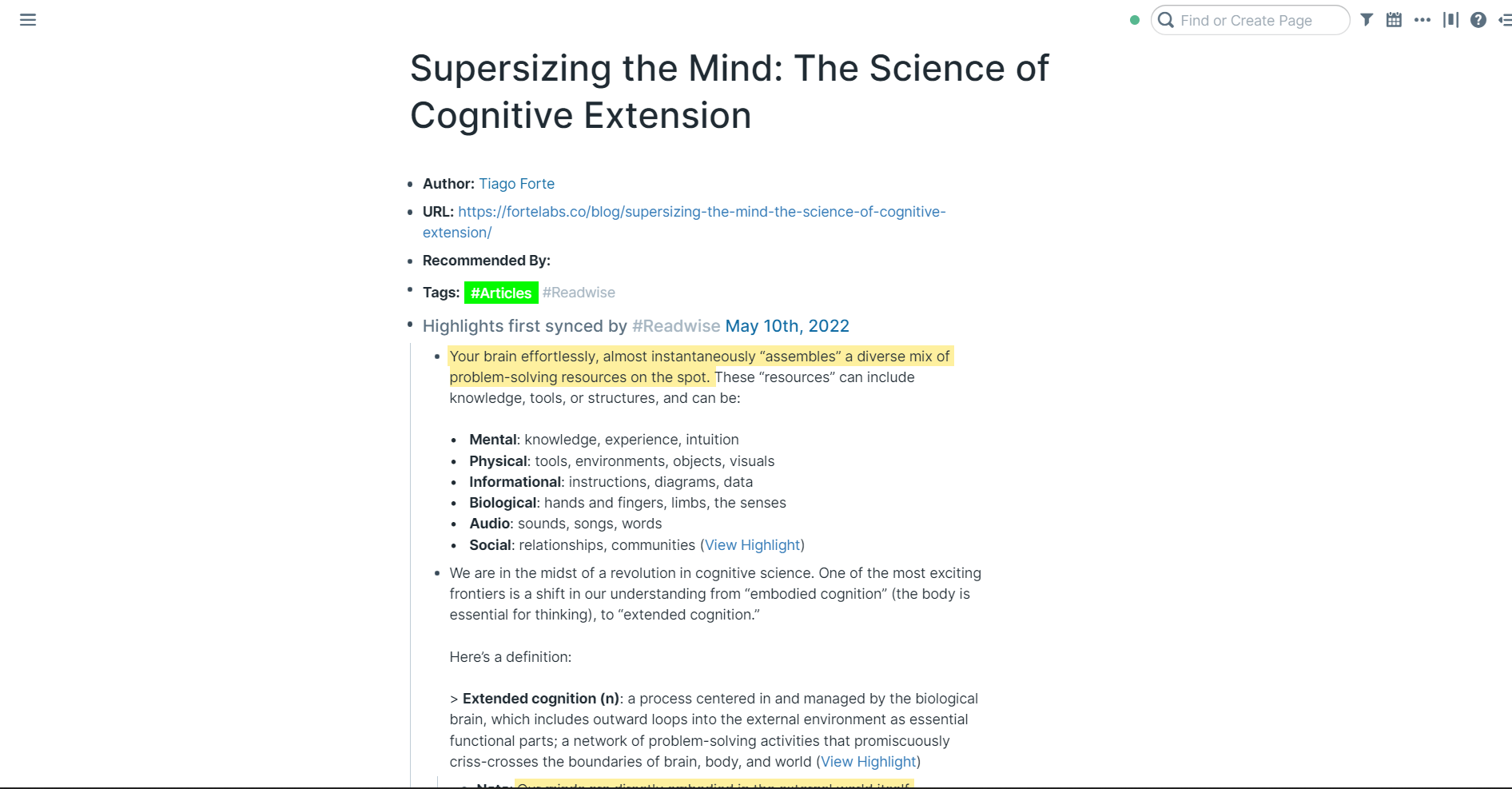
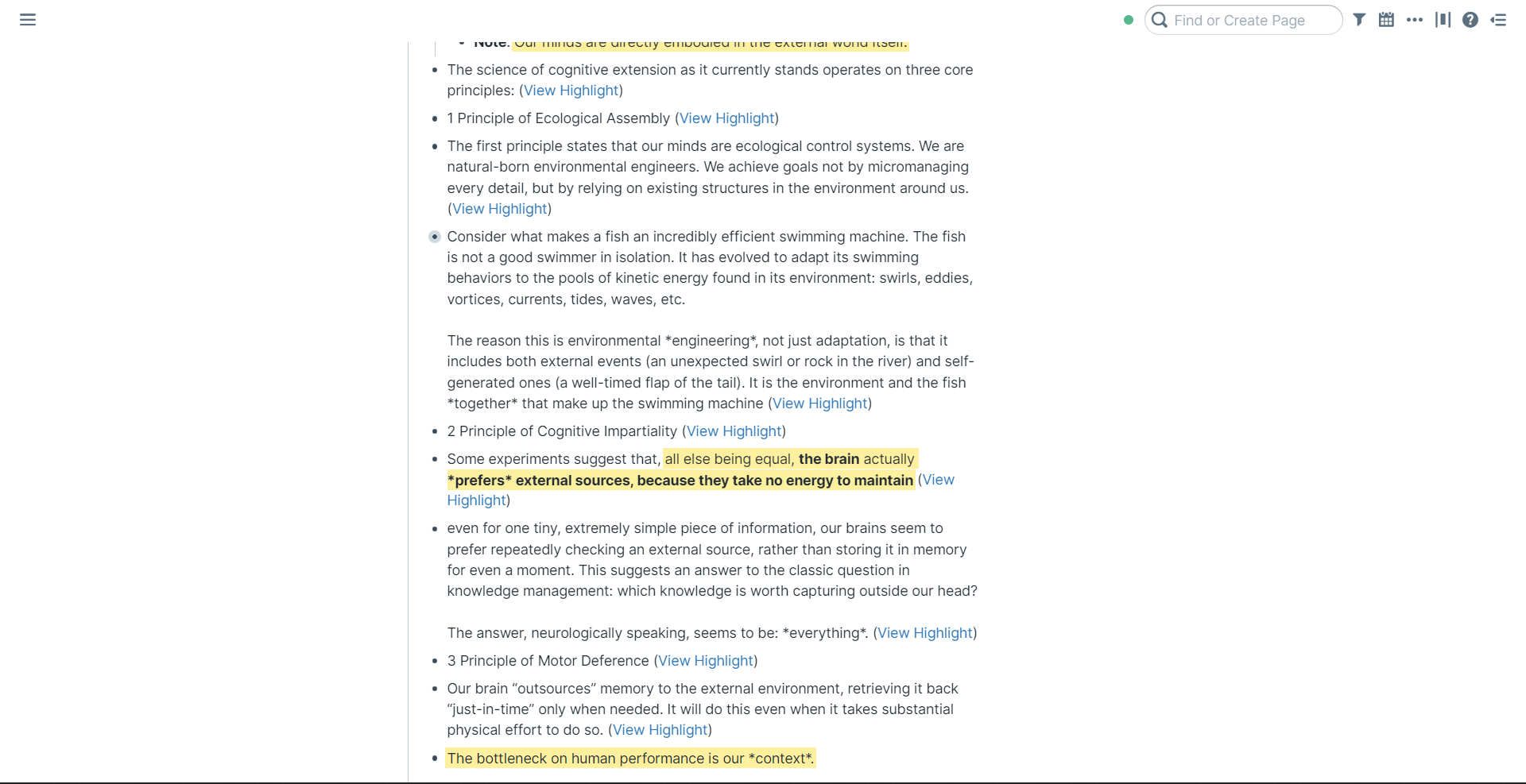
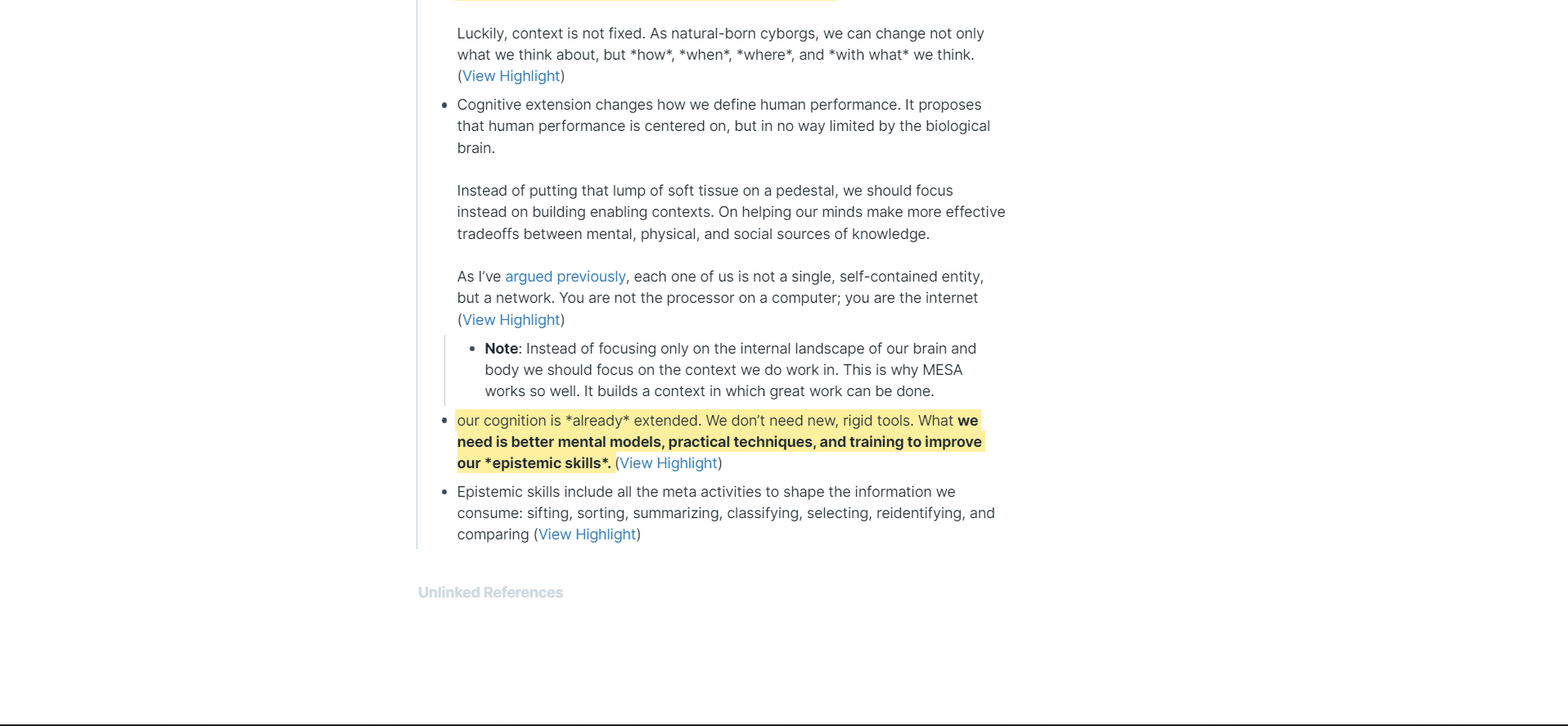
This process took me 15 seconds. Of course, some notes will take longer but every progressive summarization layering will be faster than the last.
Layer 4: Finally, layer 4 involves summarizing the key points of information at the top of the text. Usually, I write three sentences but it changes based on the length of the text.
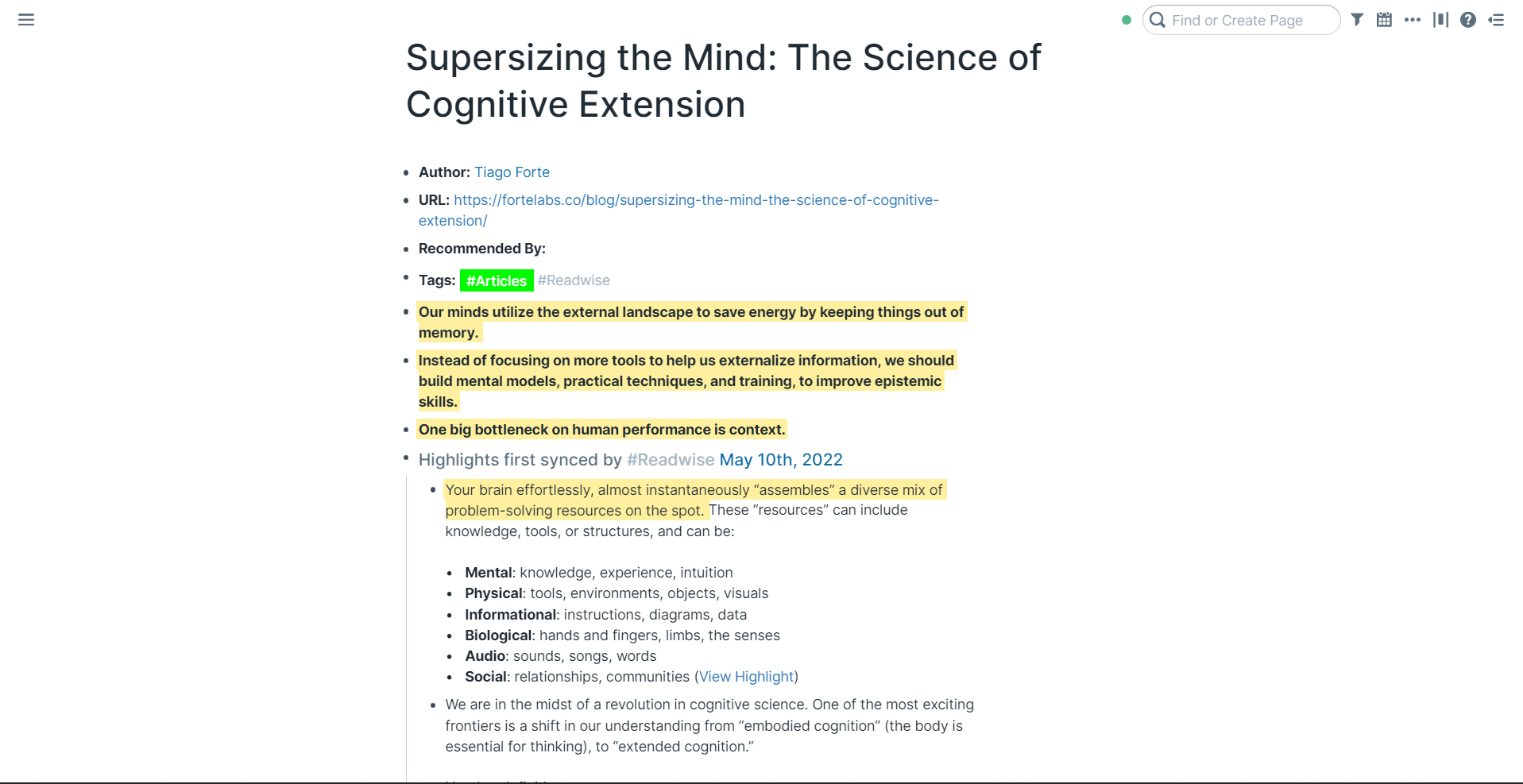
Layer 5: Layer 5 is the remixing step. This involves taking your notes and assembling them into something. You could make a video, blog post, podcast episode, anything. You don’t have to wait until a note is at layer 5—most notes I use for creation are at layer 3 or below.
The best part is this process works for any piece of information. You could do this with an email, podcast transcript, video transcript, or any other piece of information. For book summarization, it’s used to write a book summary after getting to layer 5 on a book note. It’s time to get into the writing part of book summarization.
✍️The Writing Framework
Writing is a broad field with practically infinite strategies you could use. The writing process I will show you is not the only one out there but I have found it particularly helpful for book summarization. I borrowed this writing framework from David Perell’s Riding the Writing Wave article around 6 months ago. It works in eight steps:
The Eight Step Writing Framework
- Mega Outline
- Archipelagos of Ideas
- Rough Draft
- Re-Write Every Sentence
- 10-15 Sentence Article Summary
- Send to Friends and Ask for Feedback
- Rewrite with feedback
- Publish
Let’s go over each one:
Mega Outline:
Megaoutlining is the regurgitation step; you want to get as many ideas on a document as possible. Carve out a time to create your outline. I give myself 30 minutes to an hour depending on the book length (you might need more your first time).
Split your screen into two halves, the left side with the original note and the right with your outline. Open up your layer 4 book note (it can be layer 3). Start moving through and copying information that resonates with your outline.
This is where the power of progressive summarization comes through. Your eye naturally gravitates toward the ideas your past self has deemed most important. Every idea you pull in has gone through multiple steps of validation before being included in your book summary.
Remember not to stop for too long at any one idea. Slowing down your pace might drop you out of flow.
Don’t feel obligated to stick only to ideas from the book. Add in relevant stories, facts, analogies, and humor to make your book summary unique and interesting. Remember all the annotating you did earlier? This is where they come in handy.
Like reading, having a purpose in mind while creating your outline will make it easier. For every idea I consider I ask myself, “how does this relate to building an effective reading habit?” Of course, not every idea I bring in has to answer this question but in many of my book summaries I tie back to this question.
Archipelago of Ideas:
As you add more and more ideas to your outline, themes—I like to call them archipelagos—will naturally arise. For example, if summarizing a book on writing good nonfiction, an archipelago about how to find your writer's voice might form. Once you come up with an archipelago, bold it to make it visible and cluster relevant ideas under it.
As you go through this process, you might find your outline takes more ideas from chapter 9 than chapter 1. This is fantastic! Book summaries are condensed books but should have our own spice put in. Add in your own ideas, change around the organization, and leave out entire sections if you feel it’s necessary.
After you have made your way to the bottom of the book note, make the last finishing touches on the outline. Your outline should have all of these things before you start to write:
- A logical progression.
- A hook or opener that explains or frames the book summary as a whole.
- An archipelago at the bottom of your outline for quotes. This is where you put in quotes from the author you like but don’t know where they should go in the outline.
- A section for miscellaneous. This is where ideas which don’t have a place but you know are relevant go.
- Action steps for readers at the end if you plan on sharing the book summary.
First Draft:
Awesome! Now it’s time to write your first draft. Carve out a good chunk of time (I usually write for two hours but as a beginner, 30 minutes might be better). Make sure you are in a nice environment with no distractions. Get rid of your phone or put it on do not disturb. Put your outline on the right side of the screen and your newly created book summary page on the left.
Read over your outline and make any changes you feel are necessary. It might have been weeks since you last saw your outline.
Then start writing wherever you feel most comfortable. Most of the time this will be the intro but your outline isn’t some rigid guideline. You can skip from top to bottom, middle to the top, or any mix in between. Cross off ideas on your outline as you use them so you don’t accidentally repeat an idea.
It might take some time to find a flow. Writing is hard. It helps to remember the first draft always sucks and you should give yourself a little slack. Even the best writers often go through 8 or more drafts before their book is published.
Once you get into a flow, book summarization can be one of the most enjoyable habits you have. This is why you should eliminate inhibitors to flow at every step of the process. For instance, if I ever reference something I need to link in my first draft, I will write it in a comment for my future self so I keep my flow.
I learned another cool flow trick in Nat Eliason's 21 Tactics to Help You Become a Better Writer - Nat Eliason. If you ever get stuck while writing, type TK and move somewhere else you are more comfortable. Once you feel ready ctrl + f and type TK. Because there are no English words with these two letters in sequence, you will go immediately to the section you were stuck on. Oftentimes, your subconscious has worked through your writer's block and you will know what to write.
After you finish you will emerge with what is most likely barely comprehensible garbage. This isn’t only fine but good. Editing comes in the next stage.
Re-Write Every Sentence
This next step is not for the faint of heart.
Writers often say they find their voice through rewriting. You shouldn’t see it as a detour but as an essential part of the process. If you plan on publishing your book summary—which I highly recommend—on the internet, it has to be well written.
Before rewriting you have to do a preliminary step of macro editing. Quickly read through your rough draft and make sure there aren’t any major holes. If there are, add them in now.
The first step of rewriting is to take every sentence from your rough draft and place it on its own line. Now, write another version of EVERY single sentence under its old one.
Try to make the second one flow better, more meaningful, shorter, and simpler. Don’t use big words unless they add to what you say. Don’t use words you wouldn’t in a normal conversation. Speak the new sentence out loud before writing it down. If it sounds weird to speak, it will sound weird to read.
After you’re done rewriting ALL sentences, go to the beginning and speak each old sentence aloud along with its rewritten counterpart. Choose the better sentence and delete the older one.
After you have done this for every sentence, it’s time to improve your paragraphs. Copy and paste your entire book summary somewhere else. Take every single sentence and organize them into coherent paragraphs. Then check to see that every sentence is in the best possible order.
Ask yourself these questions (but there are many others) to help: do the sentences flow together seamlessly? Is there a healthy mix of short sentences to long ones? Does every sentence make sense alongside the one before and after it?
Now, copy and paste all your new and improved paragraphs into another place. Look at the order of the paragraphs themselves. Do the paragraphs form a logical progression? Do the paragraphs create an almost storyline structure? Are they of appropriate length? All of these questions and more should be asked. Move around the paragraphs to form the best order possible.
The next step is for the big boys (and girls). Once I started doing it I took my B-level book summary to an A-level book summary.
Open a new page and write a new outline. This doesn’t have to be as in-depth as the first outline. Rather, create a skeleton structure of the headings, subheadings, and other important points you make throughout the book summary.
Then refer back to your previous book summary and start copying and pasting things in to fill the outline. If something doesn’t have a place for it, don’t be scared to get rid of it. It probably wasn’t an integral point if you couldn't recall it from memory. But don’t delete it. It could form the bedrock for future projects you undertake. Instead, put it inside of your second brain in a spot that makes sense.
Now for the last few steps!
10-15 Sentence Article Summary:
Summarize the article in 10-15 sentences.
Send to Friends and Ask for Feedback:
Send the summary to your closest friends, family, or intellectual partners for honest feedback. Try to send it to a variety of backgrounds preferably a writer, someone who doesn’t read, and any other people you can find.
It’s up to you to determine when you do this step. I generally show people only rewritten and proofread book summaries, but you can get feedback at any stage of the process. You could do this through conversation as well.
Conversing is one of the four pillars of an effective reading habit where I get the most feedback. I discuss my favorite books with my friends, family, and peers. These conversations guide my book summarization process. If I notice they didn't enjoy an idea from a book, I likely won’t include it in my book summary.
In my conversations and online, I use the CRIBS framework for feedback. CRIBS stands for Confusing, Repetitive, Interesting, Boring, and Surprising. Knowing these five things is all you need to make your writing better. If you know all five of these things about something you have written, you have all you need to make it better.
Confusing is by far the worst. If your book summary is confusing, people can’t give adequate feedback. They can’t praise or criticize it because they don’t know if the fault is with them or the text. Avoid confusion whenever possible.
Rewrite With Feedback:
Go back through your book summary and rewrite your book summary with feedback.
Repeat:
You aren’t truly finished with these steps until you can’t rewrite without questioning if it makes the book summary better. It takes an incredibly long time. Good writing doesn’t come out of anywhere.
Some of my best essays have taken more than 25 hours to write. This doesn’t even count research or other parts of the writing process like conversing and thinking. But like with any project, there will almost never be a time when you do it with 100% doneness (it’s a word. I just made it one). When you do choose to be finished, pat yourself on the back.
You created a comprehensive book summary! You probably engaged more deeply with the book than anyone else in human history. And in the process, you created a piece of intellectual property you can use for years. Now it’s time to do another one.
You won’t read nearly as many books doing this process. I won’t even get close to 62 books in 2022. But that’s okay. Because I actually remember the books I did read.
Thanks to Astrid Helfant, Skye Helfant, and Chris Lastovicka for the conversations which helped form this post.
